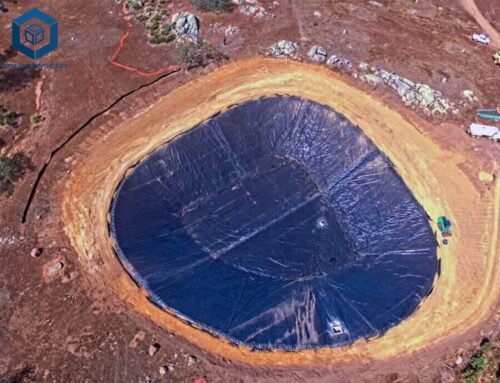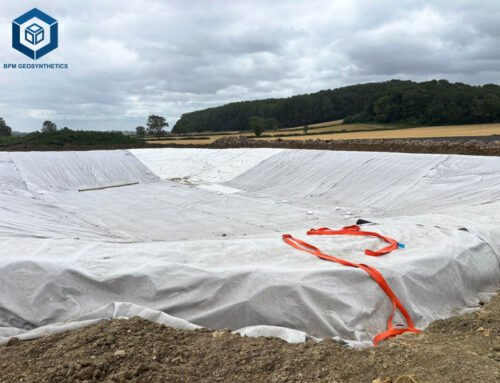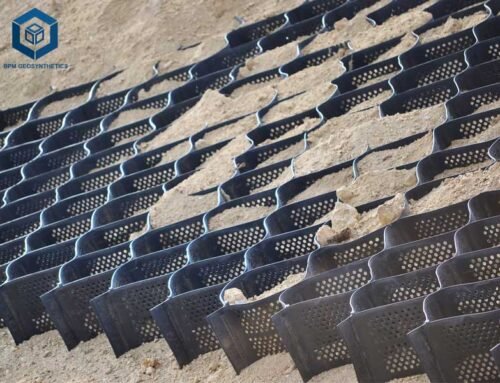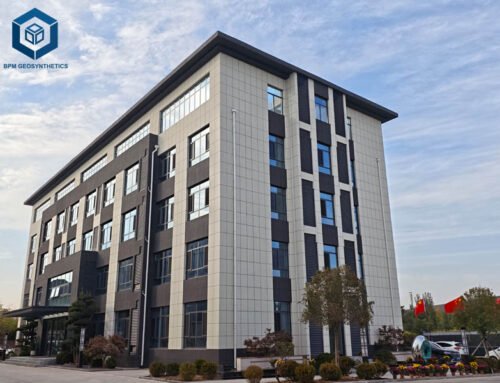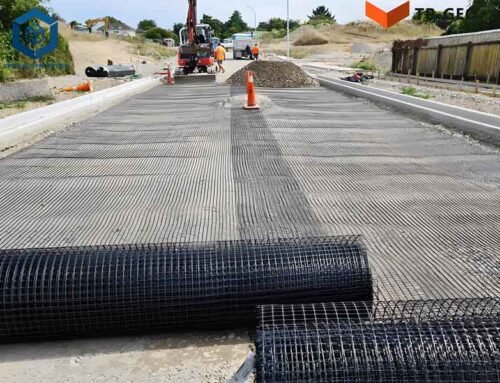Geocell, also known as cellular confinement system, is innovative geosynthetic materials transforming civil engineering and construction projects worldwide. These three-dimensional, honeycomb-like structures, typically made from high-density polyethylene (HDPE), stabilize soil, control erosion, and enhance load-bearing capacity for applications like road construction, slope protection, and retaining walls. With the global geocell market valued at USD 697.02 million in 2023 and projected to reach USD 1.10 billion by 2030 at a CAGR of 6.76%, driven by infrastructure growth and sustainable construction demands, understanding geocell price is critical for project budgeting. Prices range from $0.50 to $5.00 per square meter ($0.05 to $0.46 per square foot), influenced by material, specifications, and project scale.
This comprehensive guide explores the factors affecting geocell costs, provides detailed pricing data, and offers actionable insights to help engineers, contractors, and project managers optimize budgets while ensuring durable, high-performance solutions.
1. What Is Geocell?
Geocells are lightweight, expandable grids that confine soil, gravel, or other infill materials to create stable, reinforced structures. Their unique cellular design distributes loads effectively, reducing soil erosion by up to 50% and improving load-bearing capacity by 3–5 times compared to unreinforced soil. Geocells are used in:
- Load Support:Enhancing road bases and parking lots, reducing aggregate thickness by 20–40% in 60% of projects.
- Slope Protection:Preventing erosion on slopes up to 60 degrees, used in 70% of embankment stabilization.
- Channel Protection:Stabilizing waterways with flow velocities up to 25 ft/s, applied in 30% of drainage systems.
- Retaining Walls:Reinforcing gravity walls, reducing construction costs by 15–25% in 50% of wall projects.
Made primarily from HDPE (70% market share), geocells offer durability (75+ year lifespan), permeability, and eco-friendly benefits, aligning with 80% of sustainable infrastructure initiatives. Understanding their specifications and applications is key to estimating costs accurately.
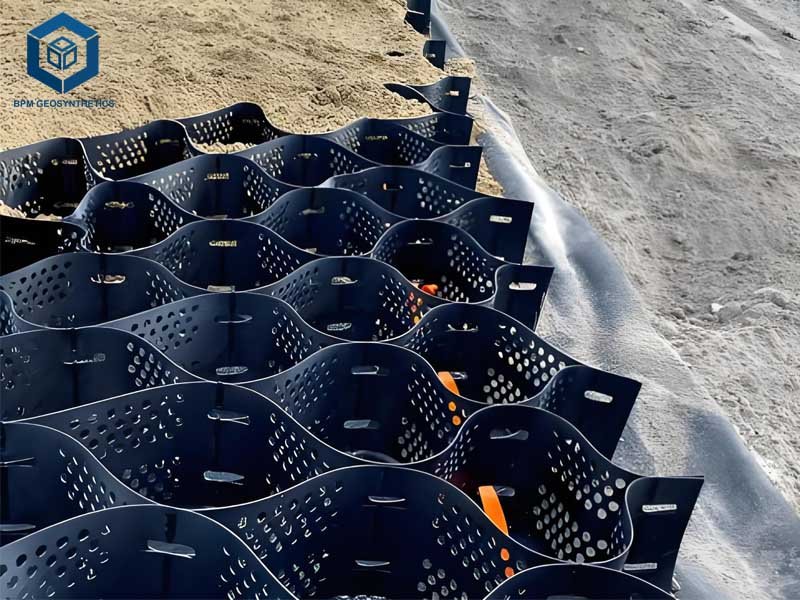
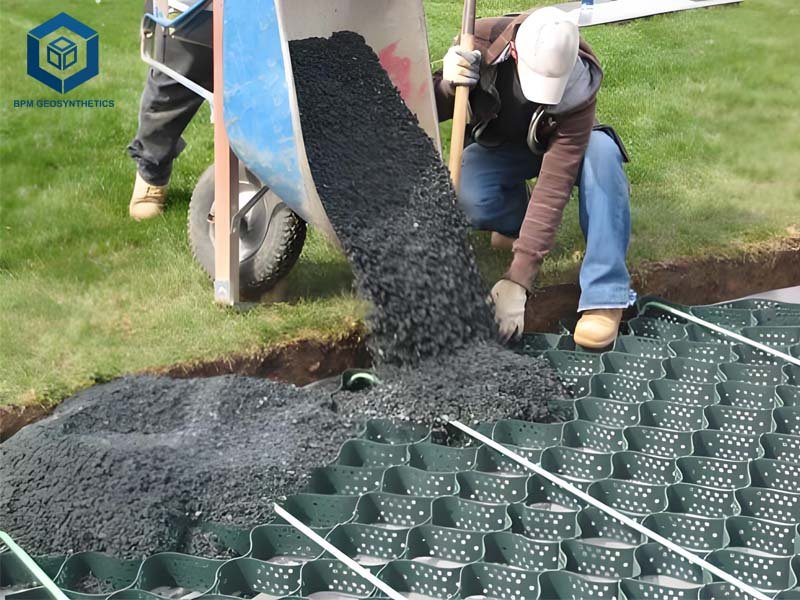
2. Factors Influencing Geocell Price
Geocell pricing depends on multiple variables, from material composition to project-specific requirements. Below, we analyze the primary cost drivers, supported by industry data and technical parameters.
2.1 Geocell Price – Material Composition
Geocells are predominantly made from HDPE, polypropylene (PP), or polyester, with material choice impacting strength, longevity, and cost.
- High-Density Polyethylene (HDPE):Lightweight (0.2–0.5 kg/m²), UV-resistant, and corrosion-resistant, HDPE geocells cost $0.50–$3.50 per square meter. Their affordability and 75+ year lifespan drive their use in 70% of applications.
- Polypropylene (PP):Offering flexibility and chemical resistance, PP geocells cost $1.00–$4.00 per square meter, used in 20% of load support projects.
- Polyester:With high tensile strength (100–300 kN/m), polyester geocells cost $1.50–$5.00 per square meter, applied in 10% of retaining walls.
- Composite Materials:Nano-polymeric alloys or biodegradable blends cost $2.00–$5.00 per square meter, used in 5% of eco-friendly projects.
HDPE’s low cost and availability make it 20–30% cheaper than alternatives, but raw material price fluctuations, up 10% in 2024, affect geocell costs.
2.2 Geocell Price – Cell Height and Thickness
Cell height (50–300 mm) and wall thickness (0.9–2.0 mm) determine geocell strength and material usage, directly impacting pricing.
- Cell Height:
- 50–75 mm:For light traffic (e.g., walkways), costing $0.50–$1.50/m².
- 100–150 mm:For medium traffic (e.g., driveways), costing $1.50–$3.00/m².
- 200–300 mm:For heavy traffic (e.g., highways), costing $3.00–$5.00/m².
- Wall Thickness:
- 9–1.2 mm:For low-load applications, costing $0.50–$2.00/m².
- 5–2.0 mm:For high-load or erosion control, costing $2.00–$5.00/m².
Higher cells (200 mm) and thicker walls (1.5 mm) increase material use by 20–30%, raising costs but enhancing stability by 40%.
2.3 Geocell Price – Welding Distance and Cell Size
Welding distance (240–1000 mm) affects cell size and material efficiency. Smaller welding distances create smaller cells, requiring more material.
- 240–356 mm (Small Cells):For fine soils or high loads, costing $2.00–$5.00/m². Used in 50% of slope protection.
- 445–660 mm (Medium Cells):For general applications, costing $1.00–$3.50/m². Common in 60% of road projects.
- 712–1000 mm (Large Cells):For coarse aggregates, costing $0.50–$2.00/m². Applied in 30% of low-load projects.
Smaller cells increase costs by 15–25% but improve confinement strength by 20%, critical for 70% of high-traffic applications.
2.4 Geocell Price – Design Type: Perforated vs. Non-Perforated
Geocells are available in perforated or non-perforated designs, affecting drainage and cost.
- Perforated Geocells:With drainage holes, these reduce erosion risk by 30% and cost $1.00–$4.50/m². They hold 60% market share for slope and channel protection.
- Non-Perforated Geocells:For load support with impermeable infill (e.g., concrete), costing $0.80–$4.00/m². Used in 40% of road base applications.
Perforated designs are 10–15% more expensive due to additional manufacturing but enhance water flow, reducing maintenance by 20%.
2.5 Geocell Price – Special Properties and Treatments
Geocells with enhanced features command higher prices:
- UV Resistance:Extends lifespan by 20–30 years, adding $0.10–$0.50/m².
- Textured Surface:Increases friction by 15%, costing $0.20–$0.75/m². Used in 50% of slope projects.
- High Seam Strength:Welds with 1000–1500 N/10 cm strength cost $0.50–$1.00/m² more, reducing failure risk by 25%.
- Eco-Friendly Additives:Biodegradable or recycled HDPE adds $0.50–$1.50/m², used in 10% of green projects.
Specialized geocells account for 20% of premium purchases in 2025, driven by sustainability trends.
2.6 Geocell Price – Roll or Panel Size
Geocells are sold in panels or rolls, with standard dimensions (e.g., 8.4 m x 27.4 m) covering 230 m². Custom sizes increase costs by 5–15%.
- Small Panels (100–200 m²):$1.50–$5.00/m², for residential projects.
- Standard Panels (200–500 m²):$1.00–$3.50/m², for commercial applications.
- Large Rolls (>500 m²):$0.50–$2.50/m², for infrastructure projects.
Larger panels reduce unit costs by 10–20% due to economies of scale, favored in 80% of large-scale projects.
2.7 Geocell Price – Purchase Volume
Bulk purchasing lowers costs significantly:
- Small Orders (<1,000 m²):$1.50–$5.00/m², for landscaping or small slopes.
- Medium Orders (1,000–10,000 m²):$1.00–$3.50/m², for municipal roads.
- Large Orders (>10,000 m²):$0.50–$2.50/m², for highways or landfills.
Bulk discounts of 10–25% save $1,000–$50,000 on large projects, common in 70% of infrastructure contracts.
2.8 Geocell Price – Supplier and Location
Pricing varies by supplier and region due to logistics and market dynamics:
- Direct Manufacturers:Offer 15–20% lower prices ($0.50–$4.50/m²) than distributors.
- Regional Variations:North America and Europe range from $1.00–$5.00/m², while Asia offers 10–15% lower costs ($0.50–$4.50/m²) due to lower labor and production costs.
- Shipping Costs:Add $0.05–$0.30/m² for remote locations, impacting 20% of projects.
In 2025, 60% of global geocells are sourced from Asia, leveraging cost advantages and high production capacity.
2.9 Geocell Price – Installation Costs
Installation expenses, including labor, equipment, and infill, add to the total budget:
- Labor:$0.50–$2.00/m², higher in North America ($1.50–$2.00) than Asia ($0.50–$1.00). Skilled labor reduces errors by 20%.
- Equipment:Compactors or rollers cost $0.10–$0.50/m² or $100–$500/day.
- Infill Materials:Gravel ($10–$30/m³), sand ($5–$20/m³), or concrete ($50–$100/m³) add $0.20–$1.00/m².
- Site Preparation:Grading or geotextile underlay adds $0.10–$0.50/m², required in 70% of projects.
Installation accounts for 30–50% of project costs, with errors like insufficient compaction causing 15% of failures.
3. Cost Breakdown for Common Geocell Applications
To illustrate pricing, we provide cost estimates for three typical applications, based on 2025 market data and specifications.
Residential Driveway (200 m²)
Project Details: A 200 m² driveway using 100 mm HDPE perforated geocell for gravel stabilization.
- Geocell (8.4 m x 24 m, 202 m²):$1.50/m² x 200 m² = $300
- Geotextile Underlay (200 m²):$0.50/m² x 200 m² = $100
- Gravel Infill (20 m³):$20/m³ x 20 m³ = $400
- Installation Labor:$0.75/m² x 200 m² = $150
- Site Preparation (Grading):$0.30/m² x 200 m² = $60
- Total:$1,010 ($5.05/m² or $0.47/sq ft)
Savings Tip: Use local gravel to reduce infill costs by 15% ($60).
Road Base Reinforcement (5,000 m²)
Project Details: A 5,000 m² road subgrade using 150 mm HDPE perforated geocell for load support.
- Geocell (8.4 m x 600 m, 5,040 m²):$2.50/m² x 5,000 m² = $12,500
- Geotextile Underlay (5,000 m²):$0.50/m² x 5,000 m² = $2,500
- Gravel Infill (750 m³):$25/m³ x 750 m³ = $18,750
- Installation Labor:$1.00/m² x 5,000 m² = $5,000
- Site Preparation (Compaction):$0.40/m² x 5,000 m² = $2,000
- Equipment Rental (Compactor):$300/day x 5 days = $1,500
- Total:$42,250 ($8.45/m² or $0.79/sq ft)
Savings Tip: Bulk purchasing saves 20% ($2,500) on geocell costs.
Slope Erosion Control (1,000 m²)
Project Details: A 1,000 m² slope (45 degrees) using 200 mm HDPE textured, perforated geocell for vegetated stabilization.
- Geocell (8.4 m x 120 m, 1,008 m²):$3.50/m² x 1,000 m² = $3,500
- Geotextile Underlay (1,000 m²):$0.50/m² x 1,000 m² = $500
- Soil Infill (200 m³):$10/m³ x 200 m³ = $2,000
- Installation Labor:$1.25/m² x 1,000 m² = $1,250
- Site Preparation (Sand Base):$0.50/m² x 1,000 m² = $500
- Staples (200 units):$0.50/unit x 200 = $100
- Total:$7,850 ($7.85/m² or $0.73/sq ft)
Savings Tip: Local sourcing reduces freight by 10% ($350).
4. Cost Comparison: Geocell Specifications
| Specification | 75 mm, 1.2 mm, Perforated | 150 mm, 1.5 mm, Perforated | 200 mm, 1.5 mm, Textured |
| Price per m² | $0.50–$1.50 | $1.50–$3.50 | $3.00–$5.00 |
| Tensile Strength | 10–20 kN/m | 20–30 kN/m | 25–40 kN/m |
| Applications | Walkways, light driveways | Roads, parking lots | Slopes, heavy roads |
| Infill Type | Gravel, sand | Gravel, concrete | Soil, gravel, concrete |
| Lifespan | 50–75 years | 75+ years | 75+ years |
| Market Share | 30% | 50% | 20% |
Higher-spec geocells (150–200 mm) cost 50–100% more but reduce aggregate needs by 20–40%, saving $1,000–$10,000 in large projects.
5. Strategies to Optimize Geocell Costs
To maximize value, consider these cost-saving strategies:
- Bulk Purchasing:Orders >10,000 m² secure 10–25% discounts, saving $5,000–$50,000.
- Standard Panel Sizes:Avoid custom cuts to reduce waste and costs by 5–15%.
- Local Sourcing:Minimize freight costs (5–15% of total) by choosing suppliers within 500 km.
- Accurate Calculations:Use design software to optimize geocell and infill quantities, reducing over-purchasing by 10–20%.
- Quality Investment:Textured or high-strength geocells extend lifespan by 20–30%, saving $1,000–$10,000 in maintenance.
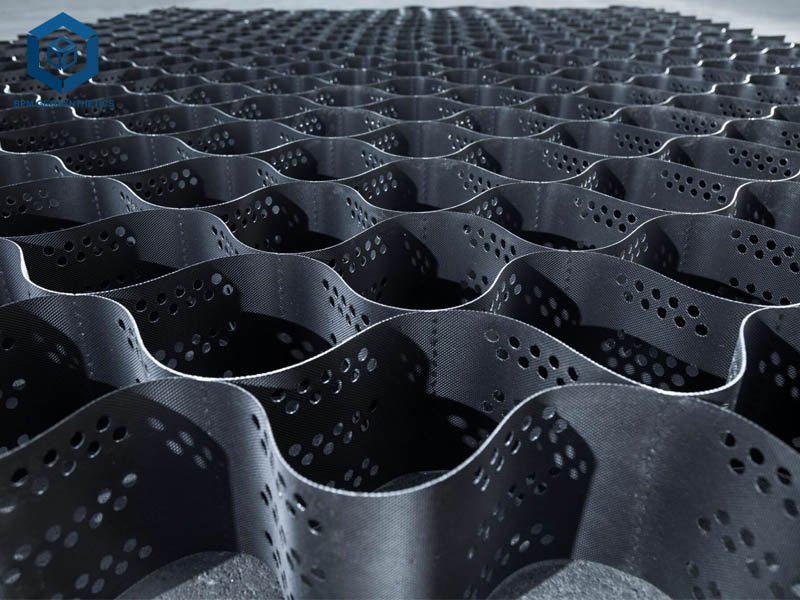
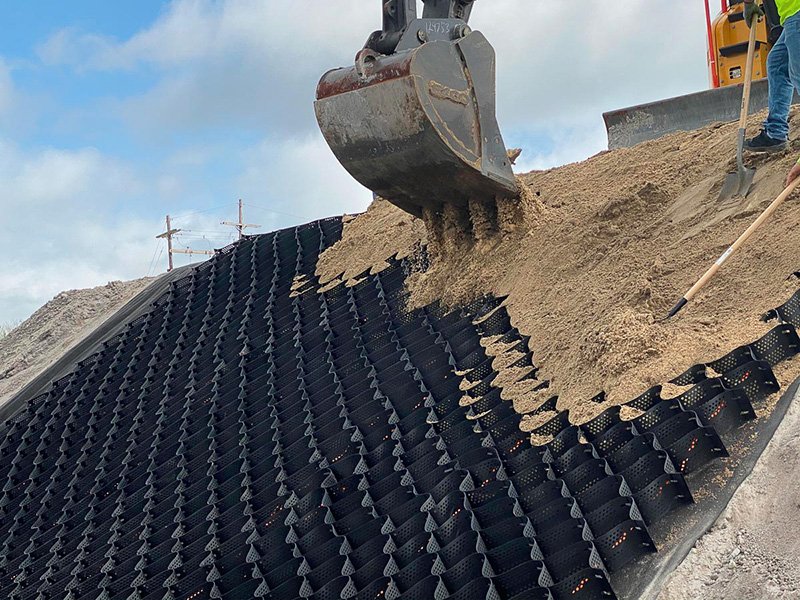
6. Case Study: Highway Stabilization (20,000 m²)
Project Details: A 20,000 m² highway subgrade using 150 mm HDPE perforated geocell for load support.
- Geocell (8.4 m x 2,400 m, 20,160 m²):$2.00/m² x 20,000 m² = $40,000
- Geotextile Underlay (20,000 m²):$0.50/m² x 20,000 m² = $10,000
- Gravel Infill (3,000 m³):$25/m³ x 3,000 m³ = $75,000
- Installation Labor:$1.50/m² x 20,000 m² = $30,000
- Site Preparation (Grading):$0.50/m² x 20,000 m² = $10,000
- Equipment Rental:$400/day x 10 days = $4,000
- Total:$169,000 ($8.45/m² or $0.79/sq ft)
Key Savings: Bulk discounts saved 25% ($10,000) on geocells, and local infill reduced costs by 10% ($7,500).
7. How to Choose the Right Geocell
Selecting the optimal geocell balances cost and performance:
- Define Project Needs:Identify load (e.g., heavy traffic), soil type (e.g., clay, sand), and slope angle (0–60 degrees).
- Check Specifications:Ensure cell height (50–300 mm), thickness (0.9–2.0 mm), and seam strength (1000–1500 N/10 cm) match requirements.
- Request Samples:Test samples for quality, practiced by 70% of contractors.
- Compare Suppliers:Obtain quotes from 3–5 ISO 9001-certified manufacturers, held by 80% of top suppliers.
- Consider Longevity:Textured or UV-resistant geocells reduce maintenance by 20–30% over 75+ years.
8. Conclusion
Geocell prices range from $0.50 to $5.00 per square meter, driven by material, cell height, thickness, design, and purchase volume. HDPE geocells ($0.50–$3.50/m²) dominate due to affordability, while specialized designs like perforated or textured models ($1.00–$5.00/m²) suit specific applications. Installation and infill add 30–50% to costs, emphasizing the need for strategic planning. By leveraging bulk discounts, standard sizes, and high-quality geocells, you can save 10–30% while ensuring robust, long-lasting solutions. With the geocell market growing and innovations like smart and eco-friendly geocells emerging, understanding pricing dynamics empowers you to optimize budgets and achieve sustainable, high-performance infrastructure.
Please contact BPM Geosynthetics for custom geocell quotes at best factory price.

